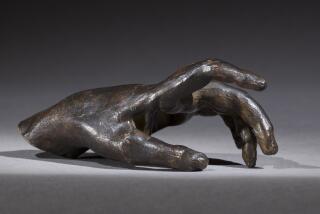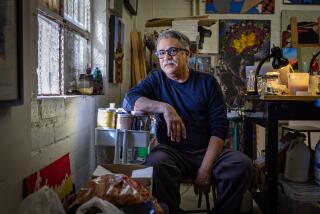Joyce Treiman; Eclectic Painter and Sculptor
Joyce Treiman, who for more than 30 years created on canvas and in sculpture a diary of both expressionistic and realistic fantasy enveloped by spiritual overtones, has died of a heart attack.
Her husband, Kenneth, said Monday that his wife was 69 when she died Sunday at St. John’s Medical Center in Santa Monica.
Mrs. Treiman, a diminutive redhead with a husky laugh and salty manner, had a sardonic attitude toward life that was reflected in her work. Her maverick approach often included placing a mocking interpretation of her own image beside her grotesque, often comical creations.
Times art writer Suzanne Muchnic called Mrs. Treiman an eclectic artist who prided herself in drawing abstracts when they were out of style or figures when landscapes were in vogue. Mrs. Treiman also was a serious art historian who had little patience with those who did not share her concern for the past.
One of her favored tasks was to journey to a country where an Old Master had labored and then imitate his style in modern settings. France and Claude Monet were particular favorites.
Her dark, cantankerous humor permeated both her conversations and her oeuvre, but the art could be as varied as the mood.
“I have always gone from heavy, heavy (subjects) to nature,” she said in one of many interviews she granted in connection with her exhibitions. “It’s sort of a release.”
Once called by Times art critic William Wilson “a painter’s painter and artist’s artist who can do any damn thing she pleases,” her recent work moved from disturbing visions to comforting landscapes.
Her battle with lung cancer, which she won, was reflected in a 1985 exhibit that contained several images of death, in contrast to the spirit and lightness of those landscapes.
At her death, Mrs. Treiman had become one of the most admired artists in Los Angeles. Her works were exhibited across the land in such museums as the Metropolitan Museum of Art, Museum of Modern Art and Whitney Museum of American Art, all in New York; at universities in Oklahoma, Illinois and Chicago, and at the Smithsonian Institution.
She was attracted to art as a young girl, but her drawing lessons did not begin until she was 14. Her family encouraged her and she enrolled as an art major at the University of Iowa, where she credited students and teachers with “sharpening my critical judgment . . . to develop a recognition of the mysterious and inexplicable essence of greatness in art.”
She turned to commercial art in Chicago to support herself after graduation. It was there in the post-World War II years that she met her husband. The six hours she spent each evening working on her own paintings paid off in sales and she was able to quit her job after exhibits at the Art Institute of Chicago and in New York.
In 1960, the Treimans moved to Pacific Palisades, where he pursued his career as a distributor of aircraft hardware and she converted the garage of their contemporary ranch house into a studio.
Her output was voluminous. She described herself as “a compulsive talker . . . but I do my talking with a paintbrush.”
Her commercial success proved a necessity for she had, like Rembrandt, a compulsion to spend much of what she earned on the art of her contemporaries.
Her awards and honors range from Ford Foundation grants to a Tamarind Lithography Fellowship. She was named a Times Woman of the Year in 1965. Last year, she was named to the National Academy of Design.
In 1988, Times critic Wilson wrote that “she has become certainly the best-known long-haul realist painter to tough it through the legitimate revolutions and silly tides that have washed California’s art beach in her time.”
Besides her husband, she is survived by a son, Donald, a sister and a brother. Services will be private but a celebration of her life will be scheduled at a later date.
More to Read
The biggest entertainment stories
Get our big stories about Hollywood, film, television, music, arts, culture and more right in your inbox as soon as they publish.
You may occasionally receive promotional content from the Los Angeles Times.










